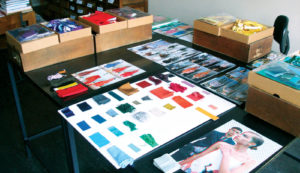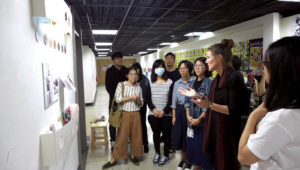
When technology and textiles intersect, it’s not surprising that the nomenclature often has us scratching our heads. Just what do we call this stuff? Smart textiles? E-textiles? Something else? Are they all the same?
If that’s not enough of a conundrum, we’ve got something else to add to the lexicon: “hybrid technology.” The term was the focus of a recent presentation at the Performance Days functional fabric fair in Munich by Annemarie van Hoof, owner and creative director of 4-Options Studio, a trend forecasting and product design and development company based in the Netherlands.
But rather than further muddy the waters, van Hoof’s explanation of hybrid technology may actually clear some things up. That’s because, van Hoof says, hybrid technology is not just words.
The definition is simple, she says: “Hybrid technology is about a mixture of different innovations or technologies within one textile, for example, maybe something that stretches but also protects against sweat.”
Cornerstone of change
But the definition, and whether the concept is interchangeable with similar terminology or not, is almost beside the point. What matters most, van Hoof says, is that hybrid technology is the cornerstone of an effort to significantly change the way products are designed and produced.
4-Options, which has been in operation since 2001, specializes in collaboration, serving as a link between technical fabric producers in Asia and Dutch designers, and as such would seem well-positioned to facilitate that change.
What that change involves, van Hoof says, is “looking first at the textile and the innovation that is available within a particular fabric, and only then starting to think about design.”
“The fashion market has traditionally worked the other way around,” she explains, “which is one of the reasons why it’s facing so many problems. So many shops that only sell ‘fashion’ have disappeared.”
“Many designers draw beautiful ideas on paper, or in 3-D on a computer, and then they start looking for textiles,” she notes. “But with our method, we help designers to create a textile vision, and then from the concept of the textile vision, we move to design.”
Rethink the system
“We don’t need to run so fast with new kinds of ideas about colors or patterns,” van Hoof says. “What we need to do is rethink the system and create ideas in a new way.”
That thinking, she says, reflects the fact that consumers are paying increasing attention to the way products are produced, what materials are used and, perhaps most important, how what they wear can make their lives easier and better. Issues such as sustainability also come into play.
Well-informed, thoughtful purchasing decisions by consumers are becoming more the norm, van Hoof says, with more people opting to purchase what they need, or what will benefit them, over what they want (or think they want).
“What we want to do,” van Hoof explains, “is produce products that are beyond those that people are interested in for one or two weeks before they want something else.”
Of course, the fashion side of smart fabrics has drawn the public’s interest because of headline-producing technology that, for example, allows evening gowns to sparkle in the dark, or T-shirts to monitor the wearer’s heart rate, or dresses to be woven with LED lights that change colors or spell out messages.
Fashion applications will always play a role in hybrid technology, if for no other reason than they can cause a stir on Twitter, but the real benefit, according to van Hoof, is in more practical applications, such as sportswear (both casual and performance-enhancing), safety clothing, and military and outdoors gear. That may not get social media in a lather, but ultimately, that’s not the point.
Putting technology in product
Besides, van Hoof explains, “While such things as wearable electronics and fibertronics attract attention, those are really most often examples of technology being integrated on products, whereas hybrid technology is more about functional textiles, about getting the technology in the product.”
For example, 4-Options works with Royal DSM, the company that produces Dyneema®, a well-known brand of high-strength fibers used for a wide variety of applications, including apparel. “They’re creating a yarn that is really strong, from which you can make a textile that is really light,” says van Hoof. “The applications are exciting, because people will be able to have all kinds of lightweight clothing, from jackets to tops to trousers, which will be a huge benefit to travelers.”
Another example is workwear that incorporates smart sensors, van Hoof says, which can promote spinal health by alerting wearers if they are hunched over for too long or standing in a bad position.
Clothing manufacturers have been working to produce outerwear that better protects people in harsh environments since the early days of Arctic exploration, and van Hoof sees the concept of hybrid technology as continuing to advance the art and the craft. While this includes finding ways to improve the efficiency of down, wool and other insulating fabrics, she says, the work also includes research into synthetic materials that can replace down and wool, and producing fabrics that are stronger and can trap heat longer.
The development of better outerwear has been affected recently because clothing that was once the exclusive province of explorers has become mainstream, with down jackets now a fashion statement. But, according to van Hoof, “It’s important not to create something just because you think it’s beautiful. Design needs to be about helping people so they will feel better or so their life will become easier.”
Education by design
At 4-Options, a key component for moving hybrid technology forward is education, and the company’s education component differentiates it from many similar organizations. The company works with university students in Taiwan and China, offering the experience of its team with the international textile and fashion industry, as well as its expertise in trend forecasting and market study. “We strongly believe that companies need to invest in knowledge,” van Hoof says.
4-Options also works to educate young designers. “There are many young people with great skills doing forward thinking in design, but there is a gap in the knowledge of textiles,” she explains. “We need to educate them, in some ways just about the basics. That’s the best way to make that bridge between these designers and the textile companies.”
“Innovation is the key to success,” she adds. “But it’s also important to look in the past, at what we have already created.”
In the end, 4-Options’s work is not about creating products, and it’s not even about creating smart products. “What it’s about,” van Hoof says, “is creating a smart experience.”
Jeff Moravec is a freelance writer from Minneapolis, Minn.
 Annemarie van Hoof, owner and creative director of Netherlands-based 4-Options Studio, is a strong advocate for a better mix of men and women on product development teams. Women have long been under-represented in product development, she says, even though they make the majority of purchasing decisions. “If you want innovation, the mix needs to change,” van Hoof says.
Annemarie van Hoof, owner and creative director of Netherlands-based 4-Options Studio, is a strong advocate for a better mix of men and women on product development teams. Women have long been under-represented in product development, she says, even though they make the majority of purchasing decisions. “If you want innovation, the mix needs to change,” van Hoof says.
 TEXTILES.ORG
TEXTILES.ORG


